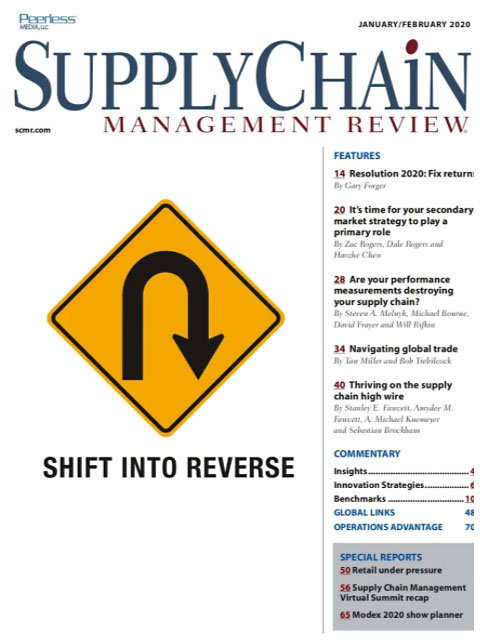Sorry, but your login has failed. Please recheck your login information and resubmit. If your subscription has expired, renew here.
January-February 2020
If the holidays at your household were like most, the gifts were chosen and wrapped with care, and then half were returned in the week after Christmas. Maybe more than half. After all, who among us hasn’t bought four shirts in a variety of sizes and colors with the intent of keeping one and returning three. And why not: Retailers and e-tailers alike have made returns seamless, easy and cheap. At least for the shopper. For the supply chains of the retailer, manufacturer or brand owner, returns are a once-neglected area that is growing into a major focus of supply chain managers who don’t want to see their organizations lose their shirt taking… Browse this issue archive.Need Help? Contact customer service 847-559-7581 More options
It seemed like such a good idea at the time. Why not pick up something not on your must-read list. And besides, the five-volume set of “Game of Thrones” was on sale. Buy it.
And then reality set in. The five books are roughly 3,500 pages. Are those tomes really going to get read? This year or next? Probably not. Back they went to the store with a couple days left on the return period.
There were no hassles at the counter. The person there just took back the set and instantly refunded your card. That’s exactly how returns should work—from the consumer’s perspective.
It was even easy to manage your return from the retailer’s perspective. It just went back onto the shelf and was added to the store’s inventory. All relatively straightforward.
So, why all the eye rolls by supply chain professionals when it comes to returns?
To begin, that scenario accounts for only a small percentage of returns in today’s retail environment. It is the low-hanging fruit.
Furthermore, the return occurred within the specified returns window, and did not require special handling or processing. It didn’t even have to go back to a distribution center and be re-integrated with existing stock. The return didn’t really cost the retailer much, if anything, to make it available once again to another consumer. Even the internal accounting was simple, as was the immediate credit to the consumer’s card.
But for the vast majority of returns, their complexity is so overwhelming that they get pushed off to an obscure corner of the distribution center. “For many organizations, the returns management process has remained a cost center with low visibility that contains products to be restocked, repaired, recycled, repackaged or disposed of properly,” says Adam Robinson, director of marketing at third-party logistics provider Cerasis. Trouble is, returns are not going away. Sure, there are times when Amazon and others tell you to keep your purchase and credit your card anyway. But that’s just a stopgap. It is not a trend.

This complete article is available to subscribers only.
Log in now for full access or start your PLUS+ subscription for instant access.
SC
MR
Sorry, but your login has failed. Please recheck your login information and resubmit. If your subscription has expired, renew here.
January-February 2020
If the holidays at your household were like most, the gifts were chosen and wrapped with care, and then half were returned in the week after Christmas. Maybe more than half. After all, who among us hasn’t bought… Browse this issue archive. Access your online digital edition. Download a PDF file of the January-February 2020 issue.It seemed like such a good idea at the time. Why not pick up something not on your must-read list. And besides, the five-volume set of “Game of Thrones” was on sale. Buy it.
And then reality set in. The five books are roughly 3,500 pages. Are those tomes really going to get read? This year or next? Probably not. Back they went to the store with a couple days left on the return period.
There were no hassles at the counter. The person there just took back the set and instantly refunded your card. That's exactly how returns should work—from the consumer's perspective.
It was even easy to manage your return from the retailer's perspective. It just went back onto the shelf and was added to the store's inventory. All relatively straightforward.
So, why all the eye rolls by supply chain professionals when it comes to returns?
To begin, that scenario accounts for only a small percentage of returns in today's retail environment. It is the low-hanging fruit.
Furthermore, the return occurred within the specified returns window, and did not require special handling or processing. It didn't even have to go back to a distribution center and be re-integrated with existing stock. The return didn't really cost the retailer much, if anything, to make it available once again to another consumer. Even the internal accounting was simple, as was the immediate credit to the consumer's card.
But for the vast majority of returns, their complexity is so overwhelming that they get pushed off to an obscure corner of the distribution center. “For many organizations, the returns management process has remained a cost center with low visibility that contains products to be restocked, repaired, recycled, repackaged or disposed of properly,” says Adam Robinson, director of marketing at third-party logistics provider Cerasis. Trouble is, returns are not going away. Sure, there are times when Amazon and others tell you to keep your purchase and credit your card anyway. But that's just a stopgap. It is not a trend.
SC
MR


Latest Supply Chain News
- How CPG brands can deliver on supplier diversity promises
- How S&OP provides the answer to in-demand products
- AI, virtual reality is bringing experiential learning into the modern age
- Humanoid robots’ place in an intralogistics smart robot strategy
- Tips for CIOs to overcome technology talent acquisition troubles
- More News
Latest Podcast

 Explore
Explore
Topics
Procurement & Sourcing News
- How CPG brands can deliver on supplier diversity promises
- How S&OP provides the answer to in-demand products
- There is still work to do to achieve supply chain stability
- Blooming success: The vital role of S&OE in nurturing global supply chains
- How one small part held up shipments of thousands of autos
- Shining light on procurement’s dark purchases problem
- More Procurement & Sourcing
Latest Procurement & Sourcing Resources

Subscribe

Supply Chain Management Review delivers the best industry content.

Editors’ Picks






